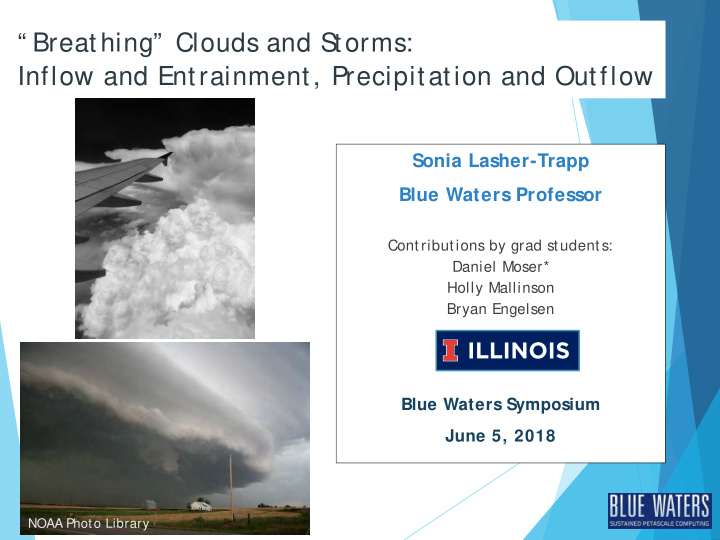



“ Breathing” Clouds and Storms: Inflow and Entrainment, Precipitation and Outflow Sonia Lasher-Trapp Blue Waters Professor Contributions by grad students: Daniel Moser* Holly Mallinson Bryan Engelsen Blue Waters Symposium June 5, 2018 NOAA Photo Library
Red: “ inhaling” Blue: “ exhaling” Dry air Entrainment
Questions: How much entrainment occurs in different stages of a supercell thunderstorm? Entrainment has a negative effect upon storm longevity and precipitation Requires high-resolution simulations with high-frequency output of large files to quantify mass flux How does cloud spacing affect entrainment? S maller gaps between clouds might “ protect” them Requires high-resolution simulations with high-frequency output of large files to quantify mass flux What kind(s) of precipitation are most important for the strength of the outflow? A stronger storm outflow can generate new storm development Requires multiple realizations of high-resolution simulations, with high-frequency output of large data files to quantify latent cooling has allowed us to pursue these questions!
Model and Analysis Tools CM1 model– George Bryan, NCAR Coarse-grained, pure MPI, 3D cloud model, designed to scale to tens of thousands of processors, written in FORTRAN 3 rd -order RK integration; 5 th / 6 th order advection NS S L double-moment microphysics (important for precip development, but increases number of calculations and memory required) Domain sizes are tens to hundreds of kilometer wide; grid spacing ranges from 50 m to 100 m to 250 m with time step < 0.1 sec ▶ Entrainment & dilution calculations (offline): ▶ Triangulation algorithm (Dawe and Austin 2011) in FORTRAN/ NCL to derive cloud core surface at sub- grid scale Creates vertical profiles of entrainment in time, and ▶ amount of core dilution ▶ Requires model output at high temporal resolution (3 to 6 seconds) Runs on single processor, but can divide the j ob up ▶ into time segments to spread work among many 5 km processors Melting ▶ Calculations of latent cooling in downdrafts (offline): Level NCL/ FORTRAN code searches for “ cold pool” & associated ▶ (3.5 km) downdrafts connected to it, at each output time VisIt useful to understand the different situations we had ▶ to address in our new analysis code!
How Much Air Do Thunderstorms “ Breathe In” ? = Ent rainment Per 2.5 hour simulation: 307.5M grid points; 14,400 node hours; 60 TB data 5 Half Gaussian – 5 km Full Gaussian – 10 km
Do cumuli growing in an environment with vertical wind shear entrain more than those growing without it? Y es, in t his part icular example, more t han 3 t imes as much! Moser and Lasher-Trapp (2018) hear No S Mass flux hear S Mass flux Lasher-Trapp & Engelsen, in prep Current work: entrainment in rotating vs non-rotating stages of supercell thunderstorms
Can Cloud Spacing Affect Entrainment? Closer-spaced clouds rain less initially, but later produce the most rainfall. Why? Entrainment differences? Not really… Moser & Lasher-Trapp, in review
Cloud 3 Cloud 4 Cloud 3 Cloud 4 Cloud B Cloud 3 Cloud 4 Cloud 4 Moser & Lasher-Trapp, in review • Precipitation-driven downdrafts from initial clouds converge in sub-cloud layer • S trong forcing of new updrafts between initial clouds leads to a second generation of clouds (named Cloud B)
Precipitation Outflows (Cold Pools) Per 3.5 to 6 hour simulation: 80M grid points; (10 simulations) 800-1450 node hours; 2 to 3.5 TB data Control Lasher-Trapp & Mallinson, in prep
Precipitation Outflows (Cold Pools) “ Control” Case S imulated Radar at 205 min Lasher-Trapp & Mallinson, in prep
ModerateWR SlowWR FastWR dBZ dBZ dBZ NarrowHail MoreIN BroadHail dBZ dBZ dBZ LessIN LessIN_IFoff LessIN_IFHMoff dBZ dBZ dBZ Lasher-Trapp & Mallinson, in prep
Latent Cooling in (initial) Downdraft vs. Propagation S peed of Outflow 10-minute r = 0.58 Lasher-Trapp & Mallinson, in prep
Integrated Latent Cooling Prior to Outflow/ Cold Pool Formation: melt ing/ sublimat ing graupel wins! Graupel Melting = -3.9 K Graupel S ublimation = -3.8 K Latent Cooling of Graupel = -7.7 K Rain Evaporation = -3 K Latent Cooling of Rain = -3 K Hail Melting = -1 K Hail S ublimation = -0.5 K Latent Cooling of Hail = -1.5 K TOTAL LATENT COOLING = -12.2 K Lasher-Trapp & Mallinson, in prep
Challenges (and simple fixes) S low I/ O, or NCL routines running out of memory output fewer variables Faster analysis with VisIt and NCL codes we “ trim” the data files, removing most of the empty space around the clouds/ storms, for analysis and longer-term storage S earching large domains for continuous surfaces meeting certain criteria (e.g. latent cooling in downdrafts that touch the ground)? Inelegant FORTRAN/ NCL routines right now Would like to know how other people do this! ▶ S torage of all these data files while we analyze them– still a problem!
Acknowledgements Blue Waters Proj ect and Team, NCS A George Bryan for use of the CM1 community model NS F (AGS -1230292, AGS – 1725190) and DOE (DE-S C0014101) Lasher-Trapp & Engelsen, in prep
Recommend
More recommend